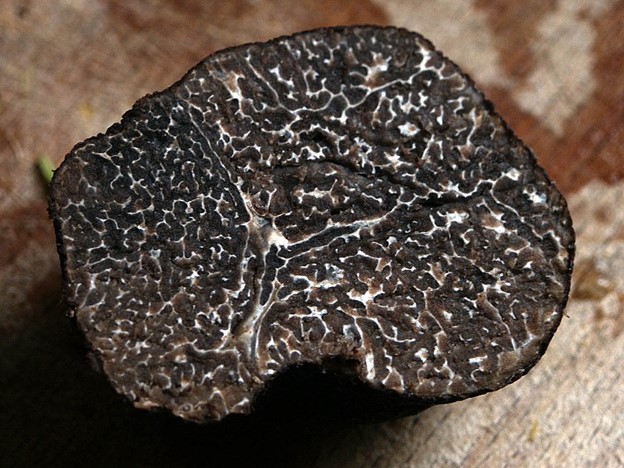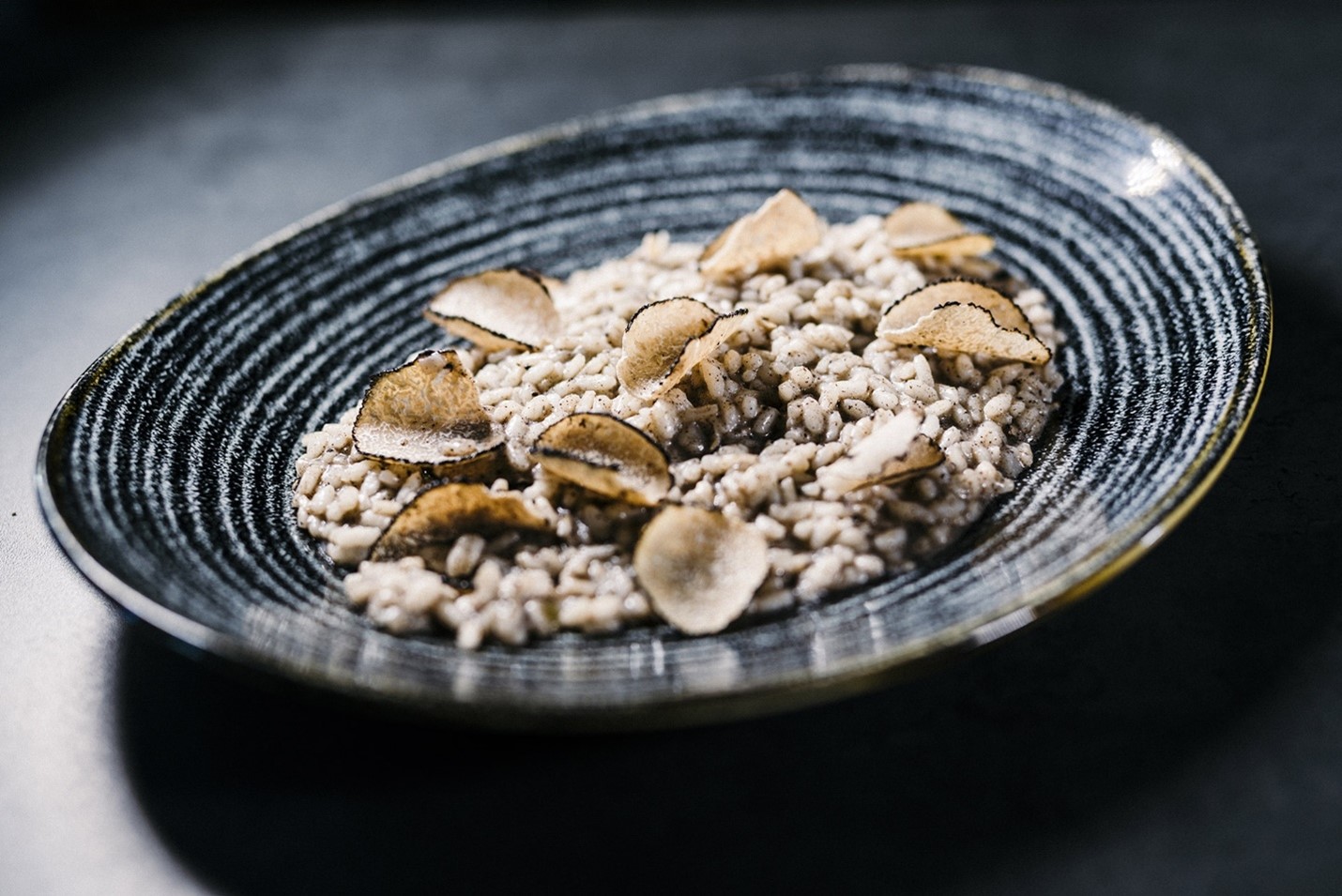The Road Less Truffled (plus a recipe for Risotto with Truffle Patè)
Ah, truffles. No, not the look-alike rich, sweet, chocolatey dessert. In this post, inspired by products from Kosherfest 2021, we explore the pungent world of the lowly and mysterious truffle tuber that grows underground along the roots of oak trees, sniffed out by trained poodles and pigs.

Used most often in both French and Italian cuisine, truffles are the fruiting body of a subterranean fungus. Edible truffles are highly prized as food, with French gastronome Jean Anthelme Brillat-Savarin calling truffles “the diamond of the kitchen.”
Although successfully cultivated in the late 19th century, the ravages of war left truffle groves in France largely destroyed or abandoned. Production plummeted, prices increased dramatically, and what was once a common ingredient became a sought-after delicacy. Cultivation is slowly increasing production, both in France and other countries around the world. They are still grown underground, and located mostly through the use of dogs, attracted to the odor of dimethyl sulfide (pigs are also used, though banned in Italy since they tend to try and eat the truffles, damaging the mycelia and lowering yield).

There are many varieties of truffles. Unlike products with protected names, vendors often use terms like “black truffle” or “white truffle” which are not specific and can describe different species with various characteristics, from rare and flavorful, to common and tasteless. If one is spending for the former, it would be disappointing to get the latter. To avoid being misled and overcharged, always check for the specific variety of tuber, using the Latin name, rather than names like “black” or “winter”. It is best to buy from a knowledgeable and reputable dealer.[1]

Here is a short guide to some common truffles on the market.
Common Name | Latin Name | Location | Season | Description | Usage | Price 1 oz |
Black, Black Winter, Périgord, Black Diamond of Provence, Queen | Tuber Melanosporum; similar: Tuber Brumale Vitt, Tuber Aestium Vitt, Asian Tuber Indicum | France, Italy, Spain, France, Australia | Late November to March | Dark, robustly-veined flesh that appears almost black-purple, with the strongest flavor and aroma of all the black truffles. Notes of cocoa, earth and tannins. | Culinary Uses: Sliced paper-thin or shaved onto meat, eggs, pasta, potatoes, and ice cream | $60-120 |
Black, Black Summer, Black Autumn, St. Jean | Tuber Aestivum | Throughout Europe, especially Eastern Europe; Italy and Spain | May to September | Black on the outside, with pale flesh that ranges from cream to grey; mild and delicate compared to the intense black winter truffle; notes of hazelnut and caramelized cream; firm, crunchy texture and bite. | Delicious and versatile, but with a less pronounced aroma and flavor than its winter cousin. Most black truffle products use this truffle. Julienned for salad, shaved raw onto warm foods, mixed into butter, oil, mild white cheese (like fresh mozzarella), garlic mashed potatoes, or other grains. | $40 |
Black, Burgundy, Fall/Autumn | Tuber Uncinatum | Italy | October-December | Similar to Summer Truffle | Similar to Summer Truffle | |
White, Winter White, Piedmont, Alba, Alba Madonna, Italian White | Tuber Magnatum Pico | Italy, Spain | September to January | Considered the most precious truffle. Yellowish color, with a smooth exterior; flavor of garlic, shallots, mushrooms, and honey; intense earthy and musky aroma | Cooking destroys the aroma which accounts for most of the flavor. Sliced thinly over a finished dish of pasta or risotto | $300-400 |
White, Bianchetto, Marzuili, Tuscan, March, Spring, Summer White
| Tuber Albidum Pico, Tuber Borchii | Italy, Spain | January to April | Less intense aroma than Winter White, generally smaller. Yellow-white or light brown. Taste can be very sharp, similar to garlic | Used similarly to the Winter White. Most white truffle products (paste, oil) are made with the Albidum truffle. Often mixed into butter or oil. It can also be sliced thinly and gently heated with parmesan cheese as an accent to bread, pasta, meat and fish. | $45 |

Because of their high price and their pungent aroma, truffles (especially winter varieties) are used sparingly. Their chemical compounds infuse well with fats such as butter, cream, cheeses, avocados, and coconut cream. Since their aroma dissipates faster when heated, they are often added to dishes raw just before serving, shaved over a warm buttered pasta or egg dish at the table. Truffles are also sometimes added to meats and cheeses, salt, and honey.
In order to get some of the flavor of truffles at a more affordable cost, truffle oil is used as a substitute for fresh truffles, adding the flavor and aroma of truffles to dishes. Commonly used as a finishing oil (like toasted sesame oil) it is used to make truffle fries, pasta dishes, pizzas, mashed potatoes, and deviled eggs. However, Caveat Emptor: as with fresh truffles, know what you are buying. Many products called “truffle oils” contain no truffles, with the majority being oil that has been artificially flavored using a synthetic agent such as 2,4-dithiapentane. While truffle oil made with real black or white truffles is prized, artificial truffle oils are berated by professional chefs.
Like any tuber (potatoes, yams, taro, ginger, jicama, and artichokes), fresh truffles are inherently kosher. Like many products, they are subject to infestation and should be checked carefully for any worms and insects. A truffle that shows damage (pin holes, exposed interior) should be avoided, but even those appearing undamaged should be cut to verify that they are free of infestation. As with most processed foods, truffle products require certification.

Truffle products from La Rustichella Truffles USA, Corp have been a regular at Kosherfest. The company imports kosher black and white truffle patès, black and white truffle oil, and tomato sauce, honey, and salt, all with added truffles (other products they carry are not kosher certified). Black truffle products are made with 10% Tuber Aesitvum Vitt (Black Summer Truffle) and white truffle products are made with 5% Tuber Albidum Pico Bianchetto. These patès also include porcini and champignon mushrooms.
I tasted both patès at kosher fest and they are savory and earthy, with a strong umami flavor. The white truffle products were somewhat more delicate than the strong, earthy black truffle patè. Both add an intense flavor to dishes like risotto, breads, pizza, or pasta, and could also be used to enhance the flavor of mild vegan cheeses. Their truffle oils, both black and white, can be used as finishing oils for a variety of foods (similar to the use of roasted sesame oil in Asian cuisine).
La Rustichella also makes Black Truffle Salt, which can be used as a regular salt substitute to add umami truffle aroma and flavor to dishes, and a truffle-infused tomato sauce that is good on pasta.

Whether you use them fresh or as pate, oil, or in other products, truffles elevate a simple dish to something sublime. Like the Traditional Balsamic Vinegar of Modena PDO discussed in earlier posts, an exceptional extra virgin first press olive oil, or a fine cognac, truffles enhance foods. Their deep, earthy flavor should not be used to overpower a dish, they can make ordinary foods special. Truffles and Risotto are a classic combination, so what follows is a recipe utilizing La Rustichella Truffle Paté, adapted from their website. Their products are certified by the OU and are available online and through kosher retailers.
_____________________
Note and Sources
[1] Two well-known distributors are D’Artagnan and Urbani Truffles.
Sources: Wikipedia, La Rustichella Truffles, dartagnan.com, urbani.com, thenibble.com, trufflesusa.com.
Photos: Black Winter By Ammontes; White Truffle Tuber magnatum by MatthiasKabel; Tuber aestivum Valnerina; all from Wikimedia Commons. Product and recipe photos from La Rustichella Truffles.
Risotto Al Tartufo (Truffle Risotto)

Bring Broth to boiling point and keep hot
Dice the onion and cook in about 15g (about 1 tablespoon) of the butter until translucent.
Add the rice and let it toast and absorb the fat
Add the wine and cook until the liquid is absorbed.
Add the broth, about ¾ of a cup at a time, stirring every minute or so until the liquid is absorbed. Keep adding broth and stirring until it is fully absorbed
Add the remaining butter, cheese, paté, salt and pepper and combine.
Top with extra cheese and, if using, thinly shaved fresh truffles.
Note: If you do not want to use a vegan parmesan, you may substitute some additional plant butter and/or cashew cream and some nutritional yeast instead. It obviously will not have the same flavor, but it will give some fat for a creamy texture and a nutty, cheesy flavor that should blend nicely. The commercial vegan cheeses continue to improve and homemade cashew parmesan is fairly easy to make, with many recipes online.
Ingredients
Directions
Bring Broth to boiling point and keep hot
Dice the onion and cook in about 15g (about 1 tablespoon) of the butter until translucent.
Add the rice and let it toast and absorb the fat
Add the wine and cook until the liquid is absorbed.
Add the broth, about ¾ of a cup at a time, stirring every minute or so until the liquid is absorbed. Keep adding broth and stirring until it is fully absorbed
Add the remaining butter, cheese, paté, salt and pepper and combine.
Top with extra cheese and, if using, thinly shaved fresh truffles.




